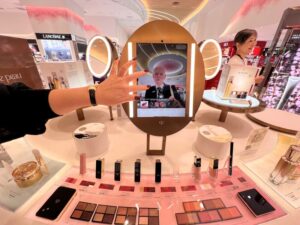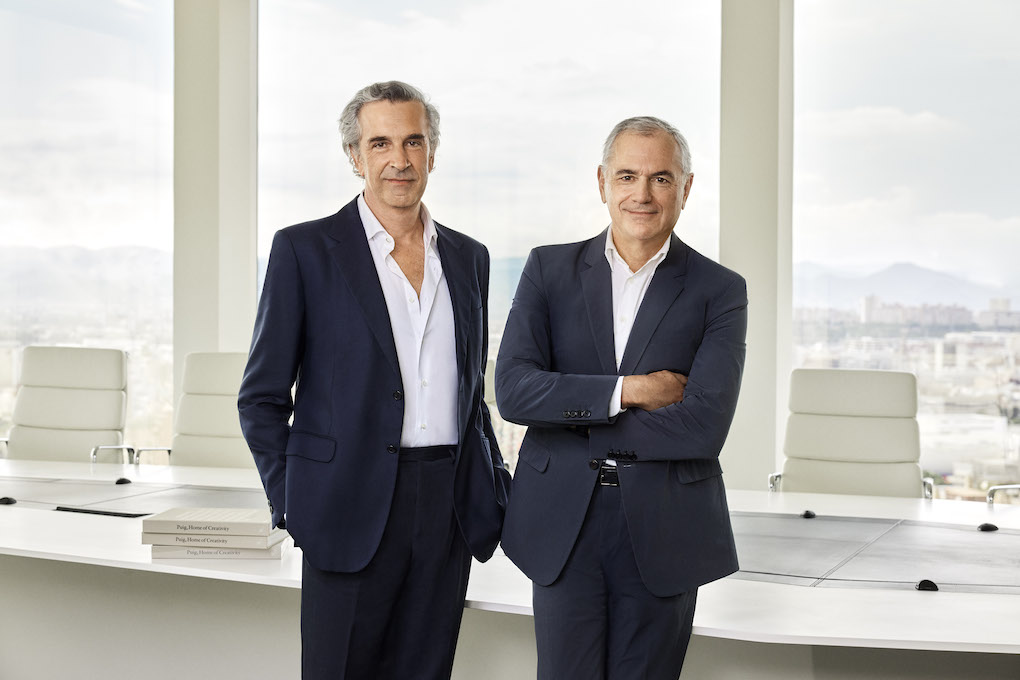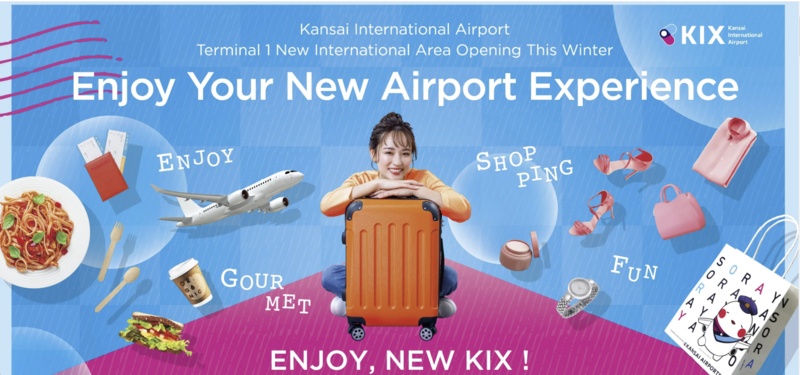
Prologue: ‘Shaping a New Journey’ proclaim the signs all around Kansai International Airport and that’s precisely what is happening at Osaka’s leading international gateway.
On 5 December, Kansai Airports’ hugely ambitious redevelopment programme saw the inauguration of the swanky new Terminal 1 airside departures area. The opening represents a critical element of a broader four-phase, five-year expansion and refurbishment of the entire international and domestic passenger facility that culminates in 2026.
The overall plan will ultimately increase international passenger capacity to 40 million (compared with around 23 million pre-pandemic). The enhancement of T1’s commercial area – both landside and airside – is key to a desired improvement of the passenger experience.
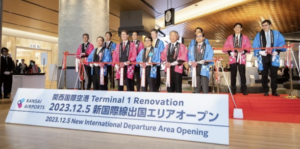
Already, an impressive array of landside food & beverage and convenience stores has opened in recent months but it was the 5 December airside opening that really marked a qualitative step change in the T1 offer.
The expansive commercial offer is anchored by a 2,500sq m KIX Duty Free walk-through store) run by Kansai Airports Retail & Services with support services from French company Lagardère Travel Retail), which opened amid much fanfare on 5 December.
 The duty free store (bolstered by KIX Duty Free’s revamped pre-order online platform) leads through to a further specialist, destination and luxury retail zone – including Louis Vuitton, Chanel, Chaumet, Gucci, Hermès, Bvlgari, Hermès and Tasaki boutiques. This upscale retail zone is complemented by a diverse food & beverage offer (including the first airport Café Dior by Anne-Sophie Pic) offering a mix of Japanese, other Asian and western cuisine.
The duty free store (bolstered by KIX Duty Free’s revamped pre-order online platform) leads through to a further specialist, destination and luxury retail zone – including Louis Vuitton, Chanel, Chaumet, Gucci, Hermès, Bvlgari, Hermès and Tasaki boutiques. This upscale retail zone is complemented by a diverse food & beverage offer (including the first airport Café Dior by Anne-Sophie Pic) offering a mix of Japanese, other Asian and western cuisine.
Passengers now enter the commercial zone far more quickly than in the past, thanks to a sleek new centralised immigration facility (which used to split in the north and south of the terminal). Once they clear immigration, they discover the duty free store, a central plaza and four contrasting ‘Mood’ areas – ‘fun’, ‘curious’, ‘active’ and ‘peaceful’ – which embrace a mix of shops and F&B. The Mood areas are designed to create an atmosphere that unites people, space and services.
The Moodie Davitt Report Founder & Chairman Martin Moodie was on hand to discover the T1 departures experience during a media tour on the eve of the opening, on inauguration day and finally as a departing passenger. Here he presents a detailed overview of what surely ranks as one of the most impressive transformations of an international airport in recent times.
“So let’s do this in the Japanese way,” said Kansai Airports Retail & Services Representative Director & President Fumio Owada as he raised his glass and proposed a toast during the evening’s celebration of the KIX Duty Free store opening earlier that day. “Kanpai!”
Owada’s smile was just about as wide as the expansive aisles in the walk-through store. And with good reason. For the store inauguration represents a transformative and perhaps definitive moment in Japanese travel retail history.
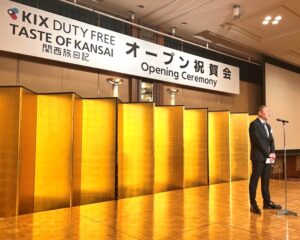
That premise was underlined by Kansai Airports Corporate EVP & CCO Non Aeronautical Stephane Geffroy, speaking moments later, who told the brand partners gathered in the room: “The project was a vision. We had to really change how we do travel retail as opposed to how we how we did it before. You all supported us and believed in that vision and that’s just fantastic.”
Pertinently Geffroy also singled out Kansai Airports Retail & Services (KRS) and Lagardère Travel Retail for praise, noting the way the Japanese and French companies had worked together to create an integrated shopping offer very different from the multi-store proposition previously synonymous with Japanese duty free.
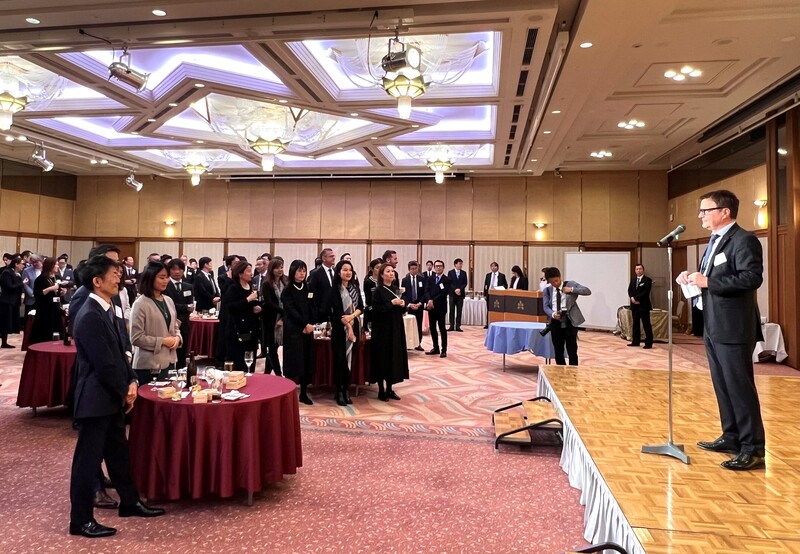
The scenes on day 1 as hordes of travellers traversed the 2,500sq m walk-through store were as encouraging as they were astonishing. As the photos and videos below show, the sheer volume of passengers and, encouragingly, shoppers, made for a hectic, even frenzied first day. And while there are clearly some work-ons – crowd management being primary – there is little doubt that Kix Duty Free represents a step change from what has gone before.
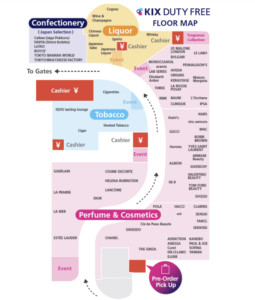
“I’m super excited, it’s just such a breakthrough compared to what we had,” says Geffroy of the duty free and wider retail offer as, surrounded by passengers, we chat in the elegant Central Plaza just beyond the KIX store.
“Basically it’s much easier to understand, because all the categories are clearly articulated, you have no duplication or replication. So you don’t have to check where you want to buy. It’s one store, one SKU and that’s very clear. It’s still a little bit limited in terms of what we could do in that space. So Phase 4 will bring +50% more space in comparison to what we have today. And then we will be in good shape to really welcome customers and have really experience-driven retail.”
Already though there is plenty of experience. And besides the single-store concept, plenty that breaks with tradition in Japan. Most notably there is the introduction of an international partner in the form of Lagardère Travel Retail, which provides a wide range of support services to Kansai Airports Retail & Services, including a supply agreement.
“It was a bit of a bet in a way,” admits Geffroy. “We had KRS the operator selected to operate the walkthrough, but we wanted them to rewrite their game. So not just to remain a pure Japanese operator but to conform themselves with what a global operator can bring. And they did it very positively.
“And on the other hand, after being selected in the tender Lagardère Travel Retail got together a team that worked very closely with KRS. There is a lot of mutual respect. And I have to say kudos to Lagardère Travel Retail for selecting the people who could really make this happen and create the chemistry between the teams. And also kudos to my team in KRS to be open to this challenge and to take it on in this way.
“The result is just fantastic. But it’s only the beginning. We really hope that this partnership can bear much more fruit than what we have just started to do and I am really positive about that.”
Creating a seamless journeyThe transformation of Terminal 1 is about far more than enhancing the commercial experience, writes Martin Moodie. Sweeping operational changes – what Kansai Airports calls ‘Fast Travel initiatives’ have also been introduced, including self check-in and bag drop, a consolidated security area, smart lanes and automated gates A critical step forward was taken on 5 December when a new consolidated immigration facility was opened, featuring 26 staffed inspection booths, eight automated gates and 23 facial recognition gates. The benefits are obvious. When I travelled as a passenger on 6 December, it took me precisely 22 minutes post check-in before I entered the KIX duty free store. For me, and for millions of fellow Kansai International Airport passengers, that increased dwell time spells greater opportunity to shop. The revenue implications are profound. |
The plan to redevelop T1, hatched in 2016 when Kansai Airport – the Vinci Airports and Orix Corporation-led consortium – took over Kansai International and Osaka International airports from New Kansai International Airport Company – really swung into action in late 2020, Geffroy explains.
“Despite this bad COVID situation, we committed to doing this, because we thought it was a great opportunity anyway, although we had no idea that COVID would last so long. But we knew we wanted to do it, the first reason being to develop more capacity for international flights. Then we wanted to take this opportunity to rethink passenger flows and to create a secondary area.
“Before renovation, airside was 47% of the Terminal 1 commercial surface. At the end of phase four, it will be nearly 70%. So that gives you a sense of the new direction we’re taking in terms of commercial spaces.”
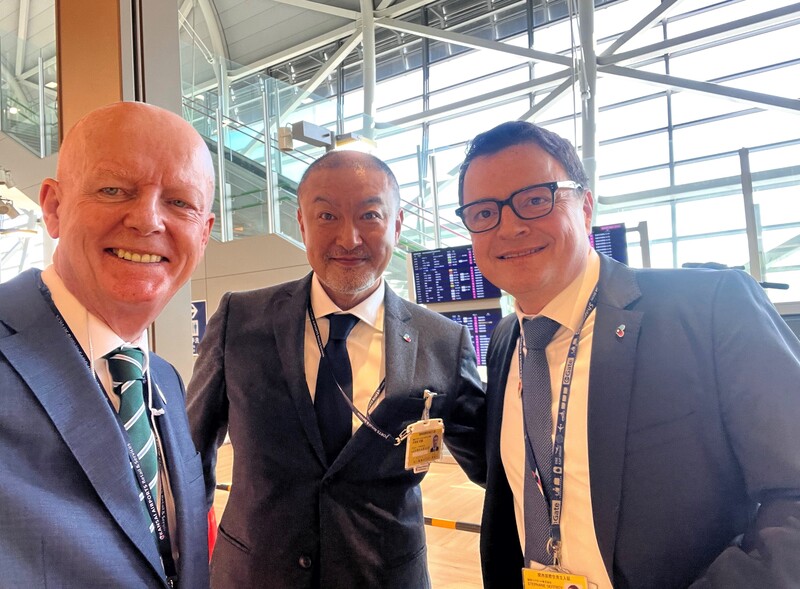
As we stand chatting in the beautiful Plaza – based on traditional Japanese architecture with a symbolic roof and pillars – my eyes take in a star-studded rollcall of expansive luxury brand boutiques.
“You see that we created stores with more space than we did before. So we really listened to the brands and their request to have a continuity in terms of experience,” Geffroy observes.
Getting my KIX en route – thrifty sixth Digital is very much to the fore in-store but I’m not sure Clé de Peau Beauté had me in mind when this superb technology was created.
|
“They are really willing to invest on the condition that they can offer a unique experience and really build their brand through travel retail. So that’s what we did. We limited the number of rounds, but really provided what we believe will be a fantastic experience for the customers.”
He continues: “What is interesting is to see the trend that some brands are moving away from duty free to get into a tax free model. So it gives them more flexibility in terms of managing their stock between the domestic market and travel retail… and also more continuity in the customer experience between their downtown stores and our travel retail stores.”
I note to Geffroy that the area fells like a new airport rather than a renovation of a facility that will mark its 30th anniversary in 2024. “Yes, it feels like that because the space has been completely redesigned and because of all the commitment from the designers that the airport hired,” he says. “But it’s also because the brands really made some incredible efforts in creating something that matches the level of design.
“So this creates an experience that we hope for all passengers will be just amazing. We want to create a destination for shopping. So the fact that we managed to attract such powerful brands will be be a reason for people who visit Japan to actually go back home through KIX rather than other airports.”
The transformation to date is impressive but plenty of work lies ahead. Next year Expo 2025 takes place in Osaka from 13 April to 13 October, after which Phase 4 – expansion of the north and south T1 commercial space – will be implement in 2026. To prepare for the culmination of this grand project, a commercial tender is likely for early 2024.
“We are looking forward to it, because there’s still a lot of interest in the next phase from many, many brands who wanted to be with us, which we were unable to welcome. So we are looking forward to the next phase,” Geffroy says.
More exciting days – and plenty more Kanpai toasts – lie ahead. ✈
A journey through KIX Duty Free
As passengers approach the impressively expansive immigration zone at Kansai International Airport’s new-look Terminal 1 airside departures zone, they are left in little doubt of the enticing brand emporium that awaits once they have cleared formalities.
For immediately post-immigration, Dior makes an emphatic statement of its luxury credentials with a total takeover of the long media wall (T1’s OOH offer is split between Kansai Airports Retail & Services for non-digital and MCDecaux, a joint venture between JCDecaux and Mitsubishi for digital).
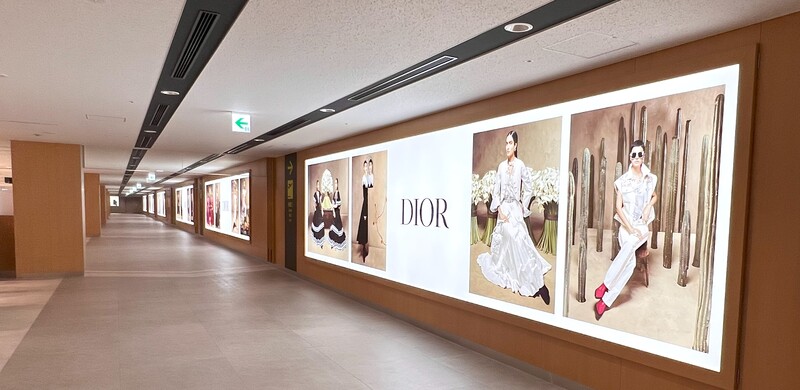
From there it’s just a few metres walk to a ride down either of two escalators riding under a big advertising lightbox (currently occupied by Chanel) and into a short transition zone, featuring a combination of static and digital advertising.
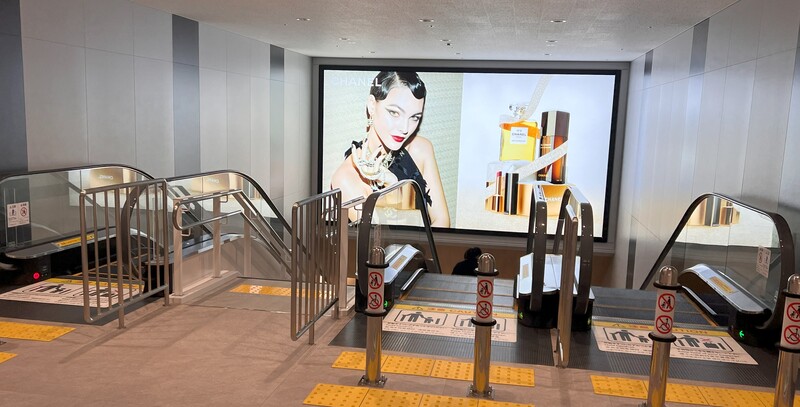
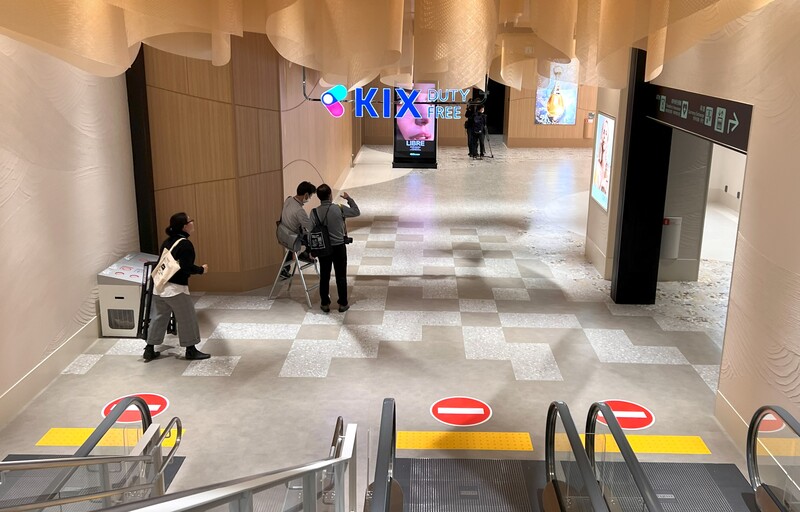
“All the departing passengers have been through security check and passport control, so we have developed a very relaxing atmosphere here so all the passengers will be ready for shopping,” explains Kansai Airports Retail & Services Representative Director & President Fumio Owada of the subtle effect of the transition area.
The walkway then swings right (see video below) and into the store proper.
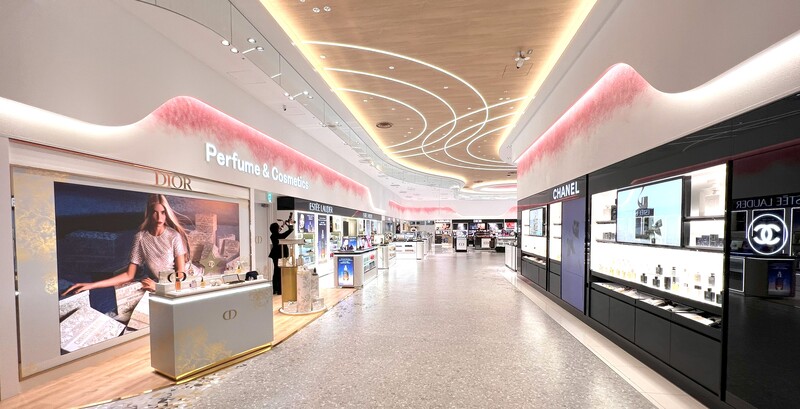
A high-profile promotion activation (currently Dior) is first up on the left followed by the permanent presence of Estée Lauder while fellow beauty sector heavyweight Chanel enjoys exclusivity on the right-hand side.
Ahead the passenger journey then takes in La Mer, La Prairie, Dior, Guerlain and Lancôme to the left and the first Japanese brand presence to the right with an impressively ranged, dramatically impactful Shiseido area (including a gondola entirely dedicated to travel retail-exclusives), bolstered by its sister brands such as Clé de Peau Beauté, The Ginza and Elixir.
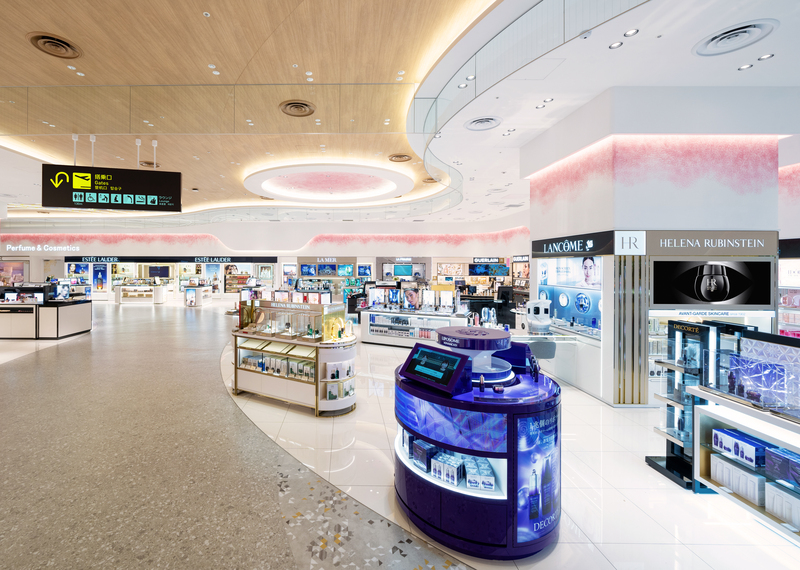
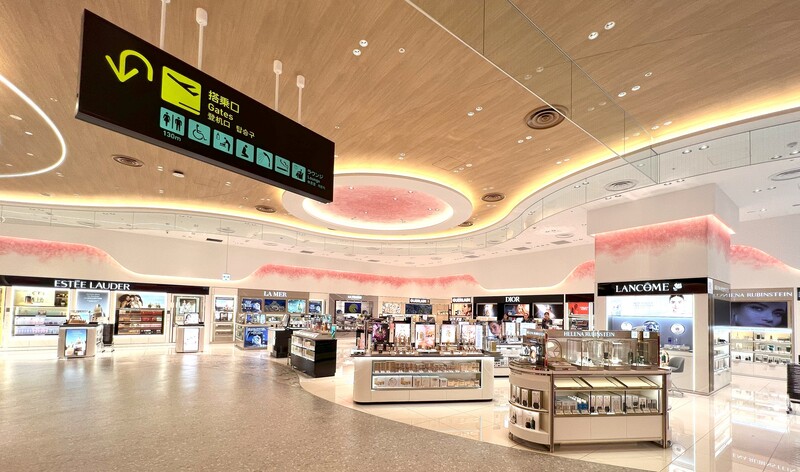
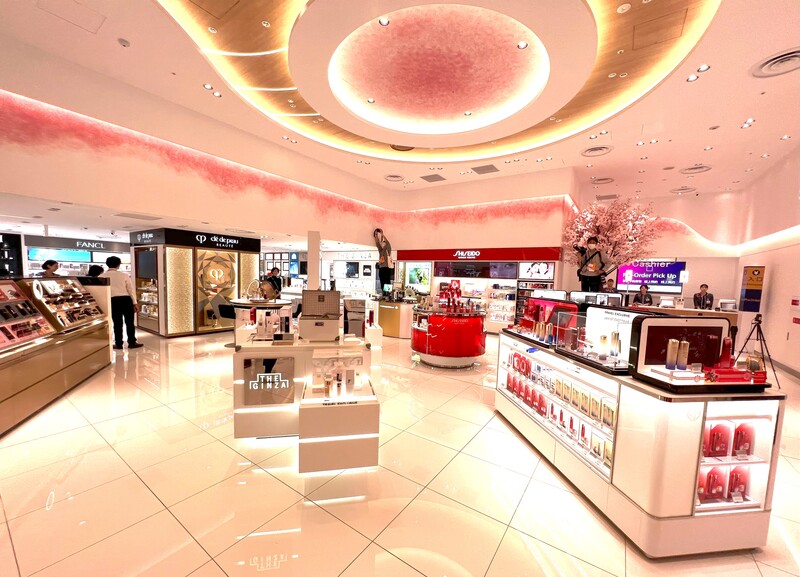

Lagardère Travel Retail VP Merchandising North Asia Terry Chua says a careful zoning philosophy underpins the expansive perfumes & cosmetics offer that covers some 70% of the store’s total space.
“We put the luxury skincare brands, which are the biggest contributors, in the beginning of the store. Then you’ll see more international brands followed by Japanese brands,” he explains. “Then we go into colour, the lifestyle brands and a fragrance corner.”
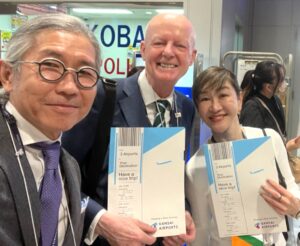
That’s a significant change from the often tobacco-led approach in Japanese travel retail. The reasoning – which seems to be borne out by the sheer volume of business being done during our visit – is that tobacco buyers will always find the department so why not expose them to other potential buying opportunities along the way.
“We offer four categories – P&C, liquor, tobacco and confectionery and each zone represents a different mood,” adds Owada. “So for the cosmetics area, for example, we made it as bright as possible. And for the liquor area, we created a woody look, so the customer can feel a change in the mood along with the changing category.”
“It’s very exciting. We’re all so proud of the project,” says Lagardère Travel Retail Senior Merchandising Director – Japan Salina Kwok, who like her colleagues has lived, slept and breathed the project over recent months. “Especially when what you see is exactly the same as the floorplan, I think the satisfaction is almost beyond words.”
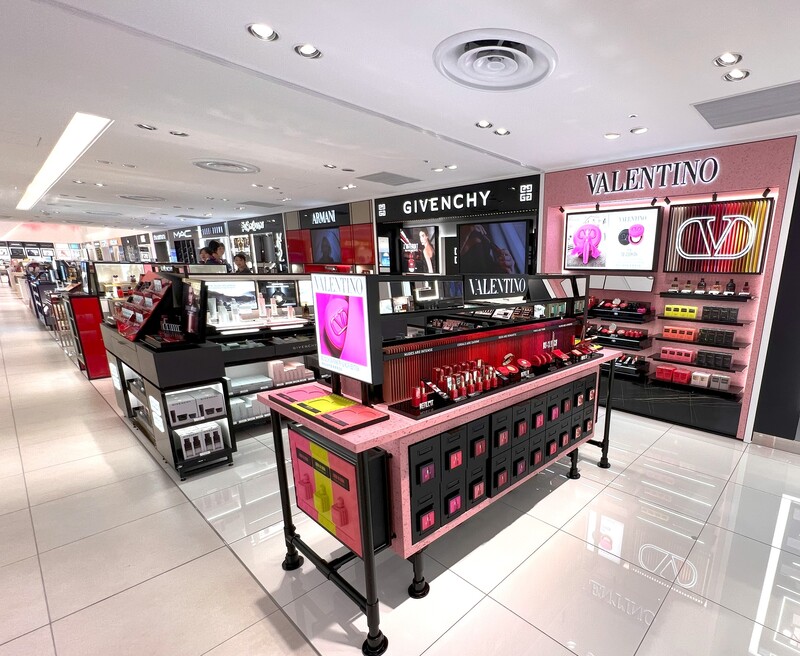
The store may be big but the visibility is excellent, a key component of the design of the beauty area in particular, Kwok points out. “When you’re standing at the centre of the store you can see from one end to another end. We like the way that the customer can navigate – it’s very easy to understand. They can always see which zone they are in.
Chua adds: “There’s a lot of comfort when you are surrounded by all the brands and you know you can get every one that you want, all very easily within reach.”
While the P&C offer is extensively ranged, the 4-metre central walkway is designed to lend a feeling of space and to allow an easy flow, Kwok explains. Based on the very heavy day-one traffic The Moodie Davitt Report witnessed, every centimetre will be vital.
That’s because compared with the old multi-retailer model the entire passenger base (and among them a high percentage who become shoppers) is concentrated in one long pedestrian flow.
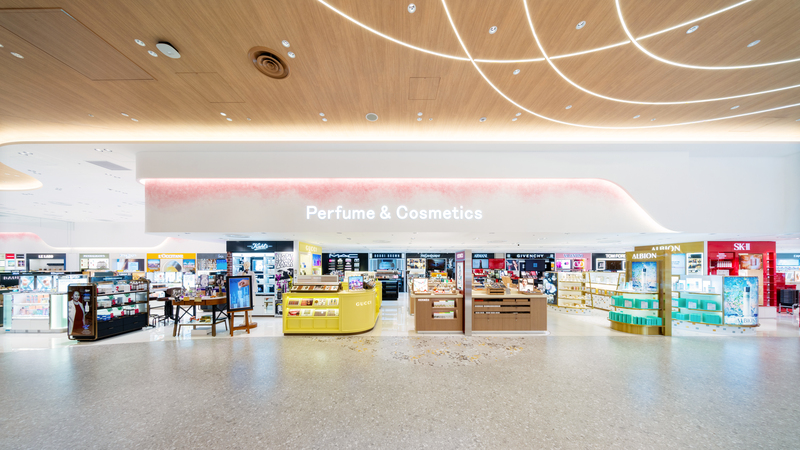
That throws up other challenges too; if a passenger decides to return back into the store to shop they are effectively – at least in peak times – going against heavy traffic.
With the anchor beauty brands positioned right back at the start of the store that poses challenges. “It means we are going to have to engage with and capture consumers immediately,” says one leading brand executive.
To address such issues KRS and Lagardère Travel Retail are working on a variety of crowd management mechanisms including a wifi-driven mobile point of sale (pictured below) that can be moved into crowded departments.
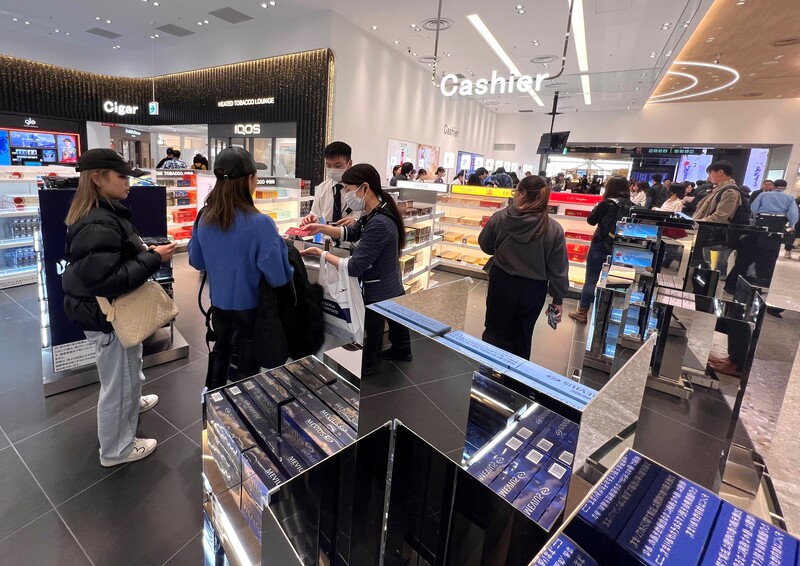
The tobacco and liquor spaces also offer many talking points. The emphasis on heat not burn, reduced-risk products (RRP) in the black and gold-hued tobacco section is notable (Japan is an RRP heartland). So is the fact that the category is positioned so deep into the store for the reasons stated above.
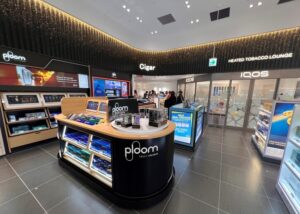
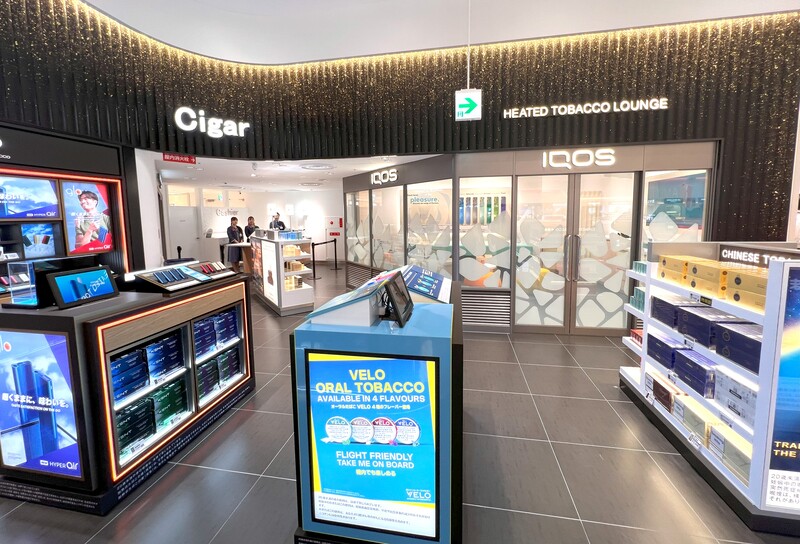
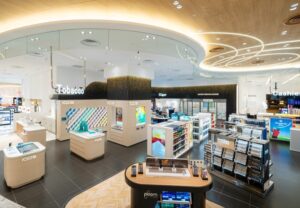
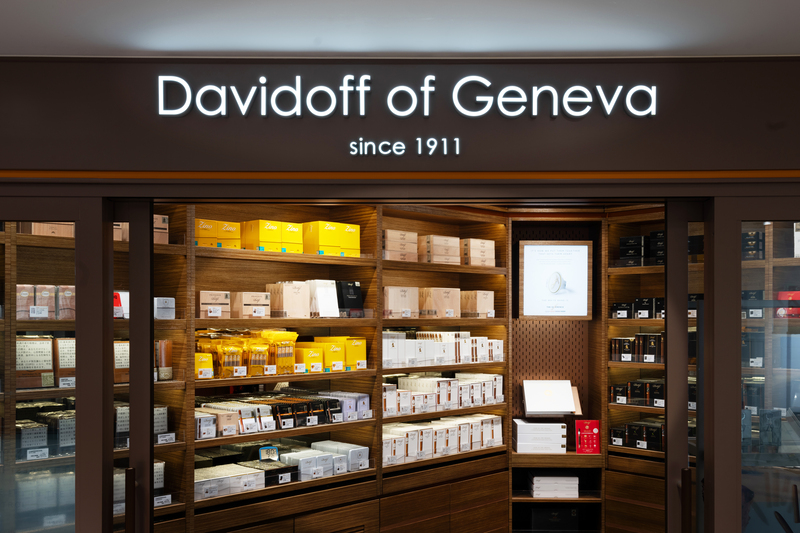

The expansive wines & spirits area is a well-ranged mix of international and local products with an impressive number of travel retail-exclusives.
“We probably have one of the most comprehensive liquor and tobacco offers in Japan travel retail,” says Owada. “We dedicated more space to liquor because it is one of the fastest-growing categories in Japanese travel retail.

“The space is basically dominated by whiskey, Cognac, fine wine and Japanese liquor {together with a solid smattering of other categories -Ed}. Together with the Lagardère Travel Retail team, we are trying to enhance the single malts assortment because other Japanese airports don’t tend to have many single malts.”
“Our team has also done a great job in expanding the Japanese assortment. Starting from sake though to whiskey and some Japanese wine.”
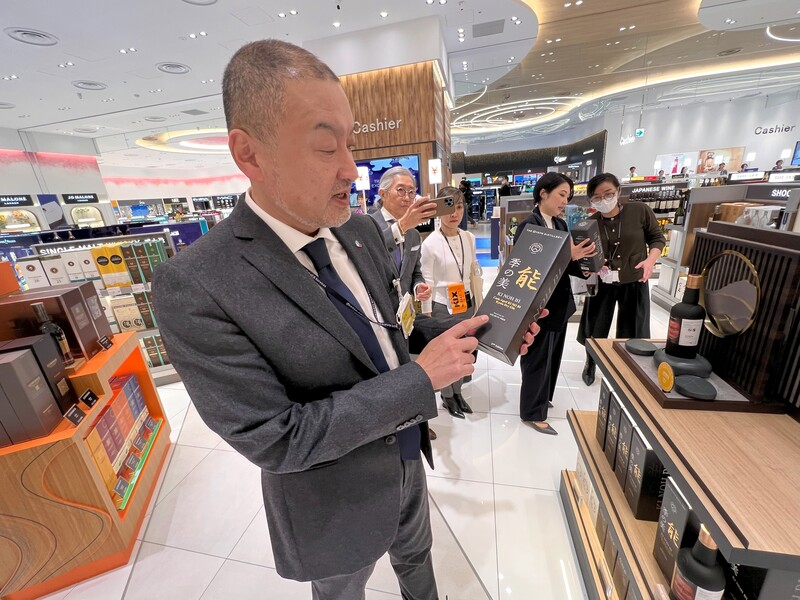
The Japanese offer pays suitable homage to Suntory, whose famed Yamazaki distillery is located just 60 minutes away by train. The facility is, like T1, being revamped and as a result, Owada was successful in convincing the whiskey-to-sake maker to bring an old bar counter to KIX Duty Free, making it a centre point of the liquor zone.

There are plentiful other local touches, including an exclusive from The Choya, the great Osaka-based Umeshu (made from Ume fruit, shochu and alcohol) producer called Ninja (pictured below).
“Choya has a factory in Iga [Mie Prefecture -Ed] which, is famous for the Ninja,” Owada explains.
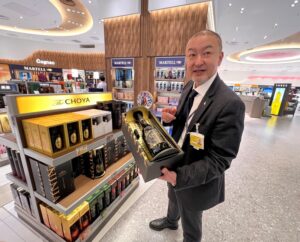
And so to confectionery – a select international grab and go assortment near the points of sale on the left and an area dedicated to hot Japanese destination products on the right. And they don’t come any hotter than Tokyo Banana (fluffy, soft sponge cakes oozing delectably with banana custard cream).
Here’s where a very significant change has taken place. Those familiar with Japanese airport retail will know well the sight of long, snake-like queues forming around Japanese souvenir shops, many of them carrying packs of Tokyo Banana, Royce chocolate or other local food and confectionery.
With a single store set-up (albeit with a Kansai-specific destination food offer just after the exit from the walk-through), it was critical to alleviate such crowding.
The solution? A combination of location, human resources and technology.
“A lot of Japanese duty free stores have the cashiers in the middle and the queues are really sneaking around the whole place making it difficult to shop,” explains Chua, indicating the long point of sale counter on the left just before the store exit, designed to ease the stress of queuing.
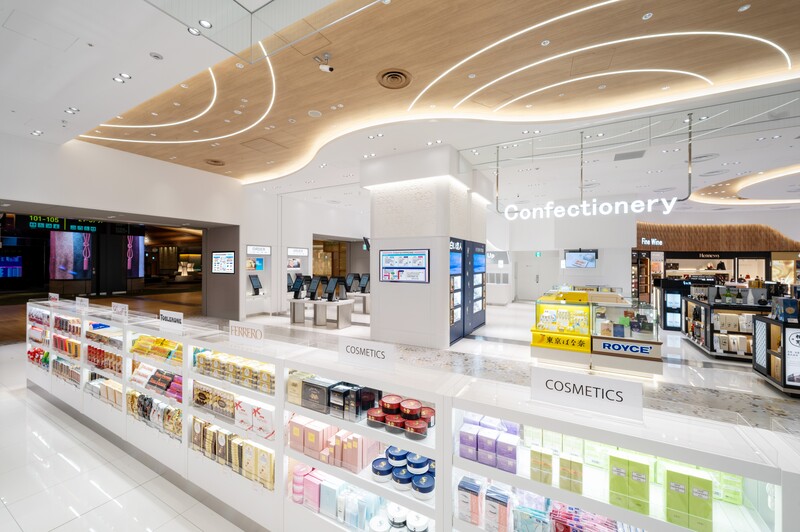
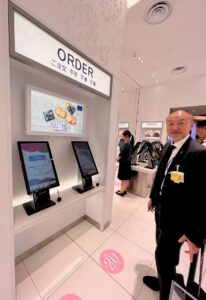 Even more important though is the use of technology to avoid the need to stock huge amounts of product in-store and constantly be restocking. “Previously, every customer had to pick up the boxes and queue to get to the cash register , which might take 10-15 minutes,” Owada says.
Even more important though is the use of technology to avoid the need to stock huge amounts of product in-store and constantly be restocking. “Previously, every customer had to pick up the boxes and queue to get to the cash register , which might take 10-15 minutes,” Owada says.
“So, with the new environment we have tried to optimise the operation. We do not stock the product here because the quantity sold is just too much.”
Instead a limited display and regular tastings allow shoppers to simply view and taste products.
They then order the product via touchscreens, receive a payment slip, proceed to payment and next (via a digital noticeboard) wait for their number to come up to collect the goods.
“So we separated order, payment and pick-up,” says Owada of a process designed to take just a few minutes.
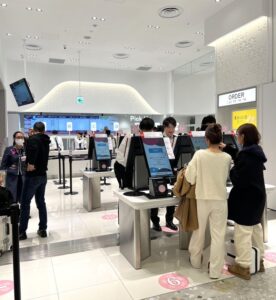
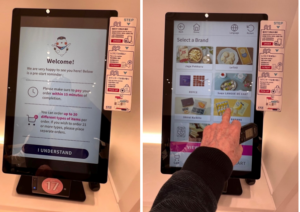
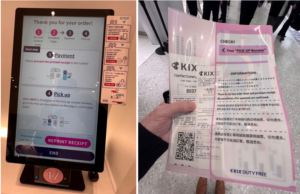
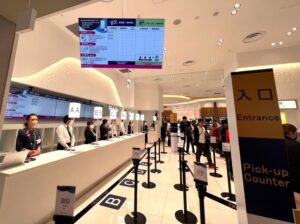
“It’s a big test, a big innovation for us,” says Geffory. “But I am sure it will bring a lot of efficiency because there are such high volumes. So it’s an opportunity to change the way we use the space.”
On my day of departure I put the system to test, ordering, paying and collecting my two brilliant yellow packs of Tokyo Banana in around eight minutes. The crucial point being that I wasn’t queuing at that time but exploring more of the retail offer. Instead of being driven bananas, I bought them. ✈






